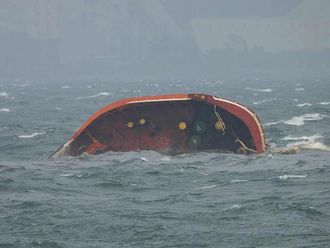Russian oil firm Slavneft said yesterday it had made a new oil find in its eastern Siberian field of Kuyumbinsky and put estimated recoverable hydrocarbon reserves at 365 million tonnes (2.5 billion barrels).
The firm, controlled by the Russian and Belarus governments, said it had struck oil last week at test well number 217, where hydrocarbons flowed at the rate of 600 cubic metres a day.
"This well indicates that Eastern Siberia could be one of the areas which holds the future of the Russian oil industry," Slavneft Vice-President Andrei Shtorkh told a news conference.
The field, comparable in size to the largest UK North Sea fields, is located in Siberia's Krasnoyarsk region, bordering China, and company officials say China would be the ideal export destination when crude production ultimately starts. Slavneft said it was now in talks with Russian and foreign companies to create a consortium to develop the field and build evacuation infrastructure.
Shtorkh declined to name potential partners but said Russia's second-largest oil company YUKOS had expressed an interest. "We estimate that about $1.5 billion in investments will be required to develop this field," Shtorkh said. "Once we create a consortium and raise financing, production could start - in a couple of years."
Slavneft said the site was distant from any pipeline routes and at least $500 million would be needed to connect it to existing infrastructure. "Obviously there is great potential for an eastbound export route with China being a natural target," Shtorkh said.
Officials said they also planned to develop the field's gas reserves, estimated at close to 200 billion cubic metres. Oil from the well was of the Siberian Light grade, a sweeter lighter variety than Russian benchmark Urals.
Slavneft also holds licenses to explore several other fields in Eastern Siberia and said preliminary studies showed that the region contained about 1.5 billion tonnes of oil, a trillion cubic metres of gas and up to 70 million tonnes of condensate. "If these estimates turn out to be correct, the Eastern Siberian region could rival the Caspian Sea basin in terms of importance to the oil industry," Shtorkh said, noting the area when compared to Western Siberia was relatively undeveloped.
Slavneft, currently a moderately-sized company, should see output skyrocket once output starts at Kuyumbinsky. It last year produced 12 million tonnes of oil but is involved in several projects including in the northern Yamal-Nenets province where it estimates total reserves at 150 million tonnes of oil.
The company is also one of the major Russian lifters of Iraqi oil under the oil-for-food programme and is planning to next month sign a United Nations sanctioned deal to develop the Suba field in Iraq.
Russian Slavneft says made huge Siberia find
Russian oil firm Slavneft said yesterday it had made a new oil find in its eastern Siberian field of Kuyumbinsky and put estimated recoverable hydrocarbon reserves at 365 million tonnes (2.5 billion barrels).












